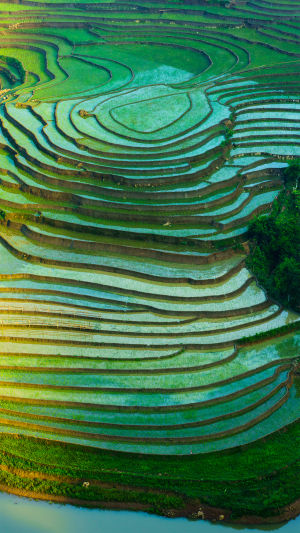Terracing, a unique form of agricultural production, takes advantage of the mountainous terrain to build a series of terraced arable fields in sequence to grow crops.
Terraces not only have a beautiful landscape value but also play an important role in agricultural production and the ecological environment.
1. History of terraced fields
Terracing is an ancient agricultural production method that first appeared in Asia. According to legend, around 2000 B.C., terracing gradually developed into the main method of agricultural production in mountainous areas of Asia, and nowadays it has become a worldwide agricultural production technology.
2. Characteristics of terracing
Terracing is an agricultural production method for mountainous terrain by building a series of terraced plots to grow crops. It takes advantage of the height and slope of the mountainous terrain to achieve sustainable agricultural production.
Terracing can save land because it takes advantage of the mountainous terrain and increases the area of agricultural production while reducing the area occupied by agricultural land and mitigating human damage to the natural environment.
Terraces adapt to the characteristics of mountainous climates, such as abundant rainfall and water, which improves the stability of agricultural production and crop yield.
3. Ecological benefits of terraced fields
Water and soil conservation
Terraces can effectively prevent soil erosion because it slows down the water flow and increases the area for soil conservation so that the soil can be better protected and utilized.
Ecological diversity
The construction and maintenance process of terraces requires the protection of mountain vegetation and the ecological environment so that the farmland and natural environment maintain a harmonious relationship, forming a rich ecosystem and a diversity of biological communities.
Water Resources Utilization
Terraced fields can make full use of water resources, and through the construction of canals, reservoirs, and other facilities, rainwater is collected and utilized, which improves the efficiency of water resource utilization in agricultural production.
4. Cultural value of terraces
Terraces are not only an agricultural production method but also a cultural heritage and a local speciality. The beautiful landscape of terraces with unique regional characteristics and cultural connotations attracts many tourists to come and watch and travel.
In addition, terraces are also an important part of local people's production and way of life, with rich local culture and folk customs.
5. Protection of Terraces
As a unique agricultural production method, terraced fields have important ecological, cultural, and economic values. Although terraces have an important role in agricultural production and the ecological environment, the number of terraces is gradually decreasing due to urbanization and industrialization, and we should reduce the destruction of terraces and protect the ecological environment.





